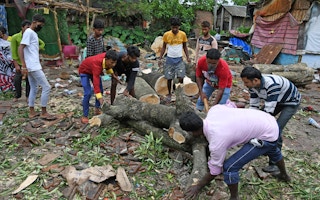India is no stranger to coping with climate extremes and natural emergencies, but this year is likely to lodge in the national memory as one of the most challenging in recent history.
The Covid-19 pandemic is a global scourge, but India also has many regional and national afflictions to make 2020 a year to forget – a massive heatwave, its strongest recorded cyclone, thunderstorms bringing huge hailstones, and floods. Now it is being assailed by all-devouring locust swarms, the worst in 25 years, leaving the land scarred.
Government figures showed more than 5,000 Covid-19 deaths by the end of May. The pandemic is causing a humanitarian crisis as well, with a huge reverse migration of penniless unskilled labourers who have lost their jobs in the cities and are now returning to their rural homes.
Five states – Rajasthan, Gujarat, Punjab, Madhya Pradesh and parts of Maharashtra – have been invaded by the locusts. The swarms normally arrive to breed in June or July but this year the first flew in in mid-April, helped to spread by a strong west wind. Climate scientists say warmer waters in the western Indian Ocean also worsened the problem.
The only saving grace is that there are not many standing crops in many of the affected districts, as the monsoon sowing is yet to begin. “It is only the vegetables, orchards and trees that are the victims of this attack,” an official said.
“
This is an emergency situation. These desert locusts will not only leave a severe impact on India’s food production but also deal a double whammy to the farmers, who are already reeling from the economic lockdown.
Devinder Sharma, food and trade policy analyst
As the locust threat developed, a range of devastating climate events hit the country in May, starting with heavy rain and hail which killed 29 people in Uttar Pradesh, India’s most populous state. Next came Cyclone Amphan, bringing sustained windspeeds of 270 kms per hour.
It was the strongest storm ever recorded in the Bay of Bengal. When it hit the coast on 20 May more than 80 people died. West Bengal, on the eastern coast bordering Bangladesh, suffered a trail of destruction. The winds even damaged the tiger stronghold of the Sunderbans, the islands whose mangrove forests in the delta of three major rivers normally give Bengal some protection from the storms.
Amphan’s rampage caused the evacuation of 300,000 people to shelter. Many acres of agricultural land near the coast were flooded by salty water and are now unusable. The government estimated the initial losses caused by the cyclone at one trillion rupees (US$13.2 billion).
Amphan’s storm surge was among its most dangerous threats. Global sea levels have already increased by about 23 cm as a result of human carbon emissions – dramatically increasing the distance that the surges can reach. Sea levels in the North Indian Ocean have risen more quickly than in many oceans elsewhere in recent years.
Assam struck
Amphan’s tail also left its mark on the northeastern state of Assam, which experienced heavy rainfall and flooding in low-lying areas, and then several days later a massive thunderstorm. On 27 May, as the Brahmaputra and its tributaries rose above danger point at several places, over 300 villages experienced heavy flooding.
Nor was that all. The same week maximum temperatures reached 40-45C° in much of northern and central India. While Delhi sizzled at 45-46°, Churu in Rajasthan touched 50°C. Fortunately, there have been no deaths reported this year of farm workers and street vendors, as many people remain locked in their homes because of the virus.
As India braces for the annual monsoon, the government is claiming that it has contained much of the locust threat. But Devinder Sharma, an agriculture and trade policy expert, said: “The government’s preparedness has been too slow to keep pace with this rapid increase in locust swarms.
“This is an emergency situation and requires emergency measures. These desert locusts will not only leave a severe impact on India’s food production but also deal a double whammy to the farmers, who are already reeling from the economic lockdown caused by Covid-19.”
This story was published with permission from Climate News Network.










